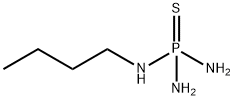Description
N-(n-Butyl)thiophosphoric triamide (NBPT), CAS 94317-64-3, is an organophosphorus compound primarily recognized for its function as a potent urease inhibitor. Urease is an enzyme that catalyzes the hydrolysis of urea into ammonia and carbon dioxide. When urea-based fertilizers are applied to soil, this enzymatic process can lead to significant nitrogen loss through ammonia volatilization, reducing fertilizer efficiency and potentially causing environmental concerns. NBPT specifically targets and inhibits the activity of the urease enzyme, thereby slowing down the conversion of urea to ammonia. This action helps to keep nitrogen in the soil for a longer period in the urea or ammonium form, making it more available for plant uptake and significantly improving nitrogen use efficiency in agriculture. It is a key active ingredient in many enhanced-efficiency fertilizer products.
Properties
Property Value CAS Number 94317-64-3 Chemical Name N-(n-Butyl)thiophosphoric triamide; N-Butylphosphorothioic triamide Common Acronym NBPT Molecular Formula C4H14N3PS Molecular Weight 167.21 g/mol Appearance Typically a white to off-white or pale yellow crystalline solid or powder. May also be supplied in solution. Melting Point Approximately 58−60∘C; some sources report up to 70∘C (varies with purity) Solubility Soluble in many organic solvents (e.g., N-methylpyrrolidone (NMP), alcohols, methylene chloride); low solubility in water. Stability Relatively stable when dry; can degrade in the presence of moisture and at elevated temperatures or acidic/alkaline conditions. Formulations often aim to improve stability. Purity/Grades Typically available as technical grade (e.g., 97%, 98%) for agricultural use or in stabilized solutions. Usage
N-(n-Butyl)thiophosphoric triamide (NBPT) is almost exclusively used in the agricultural sector as a urease inhibitor to enhance the efficiency of urea-containing fertilizers:
- Agriculture – Urease Inhibitor: It is added to urea and urea-ammonium nitrate (UAN) fertilizers to slow down the enzymatic hydrolysis of urea by soil urease. This reduces nitrogen loss to the atmosphere as ammonia gas.
- Example: Coated onto granular urea, blended with urea, or incorporated into liquid UAN solutions to create “stabilized” or “enhanced-efficiency” fertilizers. These treated fertilizers help ensure more nitrogen is available for crop uptake, leading to improved yield potential and reduced environmental impact from ammonia emissions.
- Research and Development: Used in agronomic studies and soil science research to investigate nitrogen cycling, urease activity, and strategies for improving fertilizer management.
Contact Us Now!
If you need MSDS,TDS or sample testing, please email us at pharm@sinocurechem.com or use the website live chat to get prompt reply.
- +86 13345119692
- +86 15550440621
- pharm@sinocurechem.com

